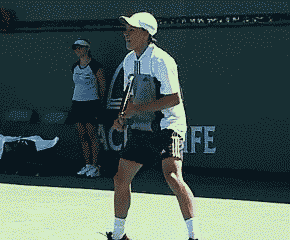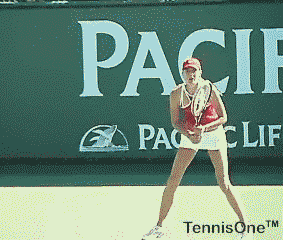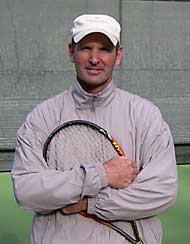
The Leverage Game: Get Behind It
Doug King
Preface: Please note that the following article is an interpretation of the changes that have occurred in tennis stroking mechanics over the last 30 years. Most of what we have seen has been an increase in power and spin - notably topspin. Although I do not address topspin in this article, I do attempt to define this modern power shift.
In a way, spin is a natural adjunct to power as it is the logical means of controlling this additional power. And although I do not specifically address taking speed off the ball, I do recognize the necessity and the value of this skill. In brief, I would say that taking speed off the ball is an exact reversal of how power is put on the ball, which I addressed in my last article "Playing By a New Set of Rules." My real endorsement for the new system articulated in the analysis below is based on the control and coordination that it affords the player - both in adding to and reducing power from the ball.
The Leverage Game
The fundamental difference between the game that is being played by professional and college players everywhere and the game that we have been brought up with is leverage. The new grips, new stances, new footwork, backswings, and follow-throughs are all related to leverage. As much as everybody is enchanted with racquet speed and blurring spin, the real significant difference between these two opposing systems, the Classical Teaching Model and the Modern Playing Style, is leverage.
The ClassicalTeaching Modelthat has been taught for years emphasized racquet "swing." "Ready position, turn, racquet back, step in, and follow through" has been the tennis teaching mantra for at least 50 years (probably more). "Get your racquet back" and "follow through over the shoulder" has been drummed into my brain since tennis infancy. What this languageis articulating isa teaching model based upon centrifugal force - that is, the swing of the racquet. The admonition to "step into your shot" is designed to increase the speed and momentum of the racquet head. "Racquet back" and "follow through" is intended to increase the arc of the swing. Power (or momentum) in this system is located at the periphery of the swing, that is the racquet head.
In essence, power has always been identified with the swing of the racquet. As much as we like to make perfunctory concessions to "getting your body into the shot," the more we talk about racquet speed, following through, stepping in, or snapping the wrist on the serve, the more we are endorsing a model based on centrifugal force instead of leverage.
What is wrong with a centrifugally based swing system? Everything. Imagine swinging a huge broom around. Long, slow, arcing swings are the result. The constant changing position of the racquet face is timing suicide. The contact between ball and racquet is more collision than actual contact. The extension of the arm is slow, stiff, and stressful to the body. Putting the momentum of the swing into the periphery, as is done with a centrifugal swing, has the effect of putting stress on the central axis - that is the body. It increases tension in the body. It is a balance nightmare and a hand/eye coordination disaster.
Leverage is the most significant difference between the Classical Teaching Model and the New Playing Style. Leverage is defined as "advantageous position." In the New Playing Style, this leverage relates primarily to the position of the body to the racquet, but it also includes the position of the racquet to the ball and the position of the eyes to the ball.
Perhaps the most significant aspect of this "advantageous position" that creates leverage is the position of the BODY BEHIND THE HANDS. Modern grips, stances, footwork, weight shift, and timing have resulted in a position that puts the body behind the hands.
You may ask "what is so new about that? We've always said hit the ball out in front of the body." Maybe so, but when you take the racquet back on the forehand and step in and then hit the ball,it is nearly impossible to accomplish this. Combine this with continental to mild eastern grips and you are simply kidding yourself - you are not hitting the ball "in front" of you.
In modern tennis power is based upon the ability to establish leverage between the body and the hands and combine this with flexion and rotation from the core. Power is derived from movement in the center and is passed to the periphery (the racquet), which is the least swinging element of the stroke. You need only look at the flying shirt tails and the abbreviated follow throughs to see what is really swinging, and what is passive.
In the leveraged based swing system, the body works like a spring to fire the arm/racquet piece. The body bends and coils for power, the arm pulls in and extends out, and rotates for torque. The body also stays behind the racquet to stabilize it and to "add more weight" to it.
There are two things that add support to the racquet - the hand and the body. When both of these are lined up behind the handle, the result is the most advantageous position and maximum leverage.
If we study how these alignments of the body and hand work we see some interesting differences. On the forehand side, the hand is in a strong leveraged position because it is strongly set behind the racquet handle. Certain grips (semi-Western) increase this leverage by putting even more of the meat of the hand and forearm behind the racquet. The body, however, is in a weak position on the forehand. The body aligns on the opposite side of the hand as the racquet. Also the body tends to shift easily in front of the racquet on the forehand side - especially if you emphasize stepping into your shot. This is why you see good players hitting off of the back foot so frequently. What they are actually doing is working to get their bodies positioned behind the racquet through contact.
On the backhand, in terms of leverage, the exact opposite situation exists. The hand is in a much weaker position on the racquet. More of the hand is on top of the racquet, but with an adequate grip change this can be greatly improved. Still it will never quite achieve the same leverage as the forehand grip - unless you go to two hands. Then the backhand grip gets even stronger than the forehand. The body, on the other hand, is in a better position on the one handed backhand. The body and the racquet align on the same side of the hand and the body more naturally stays behind the racquet. The body can still be thrown into a weak position of leverage if it shifts too quickly and over-rotates so that it is no longer situated behind the hands.
People often have difficulty changing into the more modern grips because when they do this they are actually using totally different swing models. A semi-Western grip is based upon leverage and spring from the body while a Continental grip is based upon swing of the racquet and a steady body. The roles of the body and racquet are reversed in these systems.

How to Make the Change
When you switch from a Continental to a more Western grip it must be done with the following changes. First, as you go into the hit (forehand side) tilt the body back and to the right so that you feel as though you are falling back behind the racquet. At the same time, let the elbow slide forward into the front of the ribcage and rotate the forearm so the wrist folds back while simultaneously bending your knees.
The result of all of this bending and folding (knees bend, body falls back, wrist lays back) is a soft "accepting" of the ball into the body. At the same time you are loading the body with spring and this is what is released to power the ball.
The clip of Coria shows this system in detail. The forehand starts with spring on his toes and a grip change which puts the hand in a strong leveraged position on the racquet.
Notice how he lifts the arm and shoulder without swinging the racquet back. He times the backswing to the ball and lets the arm drop and fall forward into a strong leveraged position to the body as the ball arrives. As the arm falls and slides into the ribcage the knees bend and the forearm rotates to let the racquet head fall back as the wrist lays back into contact position.
The legs lift to bring the racquet to the ball as the body stays back behind the racquet. The racquet stays solidly in position as the body springs to release the stored energy from the right side of the body. The arm lifts as the racquet stays aligned to the target which provides a controlled roll on the ball (topspin) which is essential to proper connection.
The ball and the racquet simply do not stay together this way. This strong leveraged alignment between the hand, the body, and the racquet are critical to consistent, controlled power. The power is coming from the coil and spring of the body.
Notice the rhythmic bouncing in the balls of the feet and the spring in the knees. This is the real "swing." Notice also that there is little swing of the racquet out to the target which is so emphasized in the Classic Model. In reality, there is little connection to the ball by reaching out to the target. (See "The Rules of Engagement" in my article "The One Handed Topspin Backhand, Part II for more on "connection".)

In the Classic Model the emphasis is on stepping out to the ball, swinging the racquet to the ball, and swinging "through" the ball. All this does is spend the spring, the energy stored in the body, before the ball arrives and creates a slapping contact between the racquet and the ball.
In the Classic Model the body and the feet are controlled in specific positions and patterns that are restrictive and distractive. We are encouraged to get the feet "set up," keep the body "down," and follow through with the racquet. This is in exact contrast to what we see today. The feet are liberated into freer positions that allow more flexibility and adjustability to the ball. The body springs and flies to the extent that we see airborne stroking almost becoming commonplace.
Follow throughs are all over the place - dying into the ribcage, ala Federer, Coria, Safin, Keifer or over the head of the same hitting shoulder ala Davenport, Nadal, Sharapova. All of this points to the shift of the power base from the swing of the racquet (centrifugal force) to spring of the body (leverage).
Leverage Tips
To learn proper leverage, it is important to understand that the body is the spring and the racquet should not swing - "SPRING DON'T SWING" should be your motto.
The racquet should align and "connect" to the ball. As the body springs, the racquet holds it's alignment to the ball and target. This is why I say the racquet is the least "swinging" element of the stroke. The racquet does not change on the ball (or very little) but the feel in the body changes dramatically while the ball and the racquet make contact.
- Don't hurry your backswing.
- Fall back and absorb the ball.
- Don't rush the racquet to a follow through.
- Keep the racquet and the ball connected by keeping the hand relaxed.
- Spring the body, extend the arm, but don't "swing" the racquet."
Try the demonstration shown on the right. Have your partner roll the big ball to either side of you. This will give you the feel of moving your feet to position you behind the ball and using your legs, back, and shoulders to release power on the ball.
Conclusion
The leveraged swing system creates connection between the racquet and ball, the power being based upon the release of stored energy from the body. The centrifugal swing system creates collision between the ball and racquet as it is based on racquet speed.
Power is delivered in shorter bursts, in shorter spaces with the leveraged system. The centrifugal swing may look smoother but in reality it is slower and less able to react to the ball. It is also devoid of acceleration which is a critical component of the leveraged swings of modern tennis. Remember, the leverage system is the key to moving ahead so my advice is, "get behind it".
Your comments are welcome. Let us know what you think about Doug King's article by emailing us here at TennisOne.
![]()

 Doug King studied with legendary tennis coach Tom Stow and was a former California State Men's Singles Champion and the former number one men's player of Northern California.
Doug King studied with legendary tennis coach Tom Stow and was a former California State Men's Singles Champion and the former number one men's player of Northern California.
Doug is one of the country'sforemost tennis teaching innovators. Founder of Acceleration Tennis, a revolutionary teaching system, King is leading the way in reinterpreting the traditional tennis model.
Doug King is currently Director of Tennis at Meadowood Napa Valley ( www.meadowood.com ), a Relaix Chateau Resort in St. Helena , CA .
For more information on Acceleration Tennis please email Doug King at dking@meadowood.com.